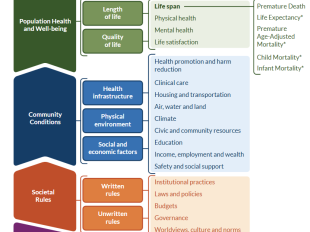What’s in a disparity rating? Simple yet nuanced is key to a successful tool
In an earlier post we introduced our quest to develop the most useful, effective tool to identify solutions that reduce disparities*. As part of that quest, the What Works for Health team recently engaged scholars and practitioners who use the tool in their communities. The discussions revealed a tension familiar to those in public health: How can we communicate complex information in a simple way while still maintaining accuracy and nuance?
The answer may lie in the context. Several ideas emerged to provide more details in addition to the rating, such as a clearer connection to root causes of inequities and historical background.
While we heard feedback on the value of simplicity in the current disparity rating and how it can be applied to address disparities in communities, scholars urged caution about oversimplifying a strategy’s potential impact on disparities. They said an oversimplified tool could encourage misinterpretation and misuse. For example, a simplified rating without context may be incorrectly interpreted as a guaranteed, evidence-backed strategy to decrease disparities.
In fact, scholars and practitioners cautioned that a strategy’s impact can change depending on how it is implemented. For example, a program rated “likely to decrease disparities” could fail if implemented with few resources or if the program wasn’t tailored to the needs and opportunities of the local population. The success of the What Works for Health strategies in reducing disparities is dependent on thoughtful and careful implementation. To make this clear, it is important to offer guidance and examples of how communities have successfully implemented strategies.
One key recommendation from the scholars and practitioners we engaged is to consider the full spectrum of research to provide a comprehensive understanding of a strategy’s likely impact on disparities. In addition to peer-reviewed journal articles, this would include more diverse perspectives such as community reports.
As we continue to innovate our disparity rating methods and refine What Works for Health to better serve efforts to advance health and equity, we want to hear from you!
Let us know your thoughts and ideas by emailing [email protected].
* Health disparities, also known as health inequalities, refer to plausibly avoidable, systematic health differences adversely affecting economically or socially disadvantaged groups (see What is Health Equity?)



